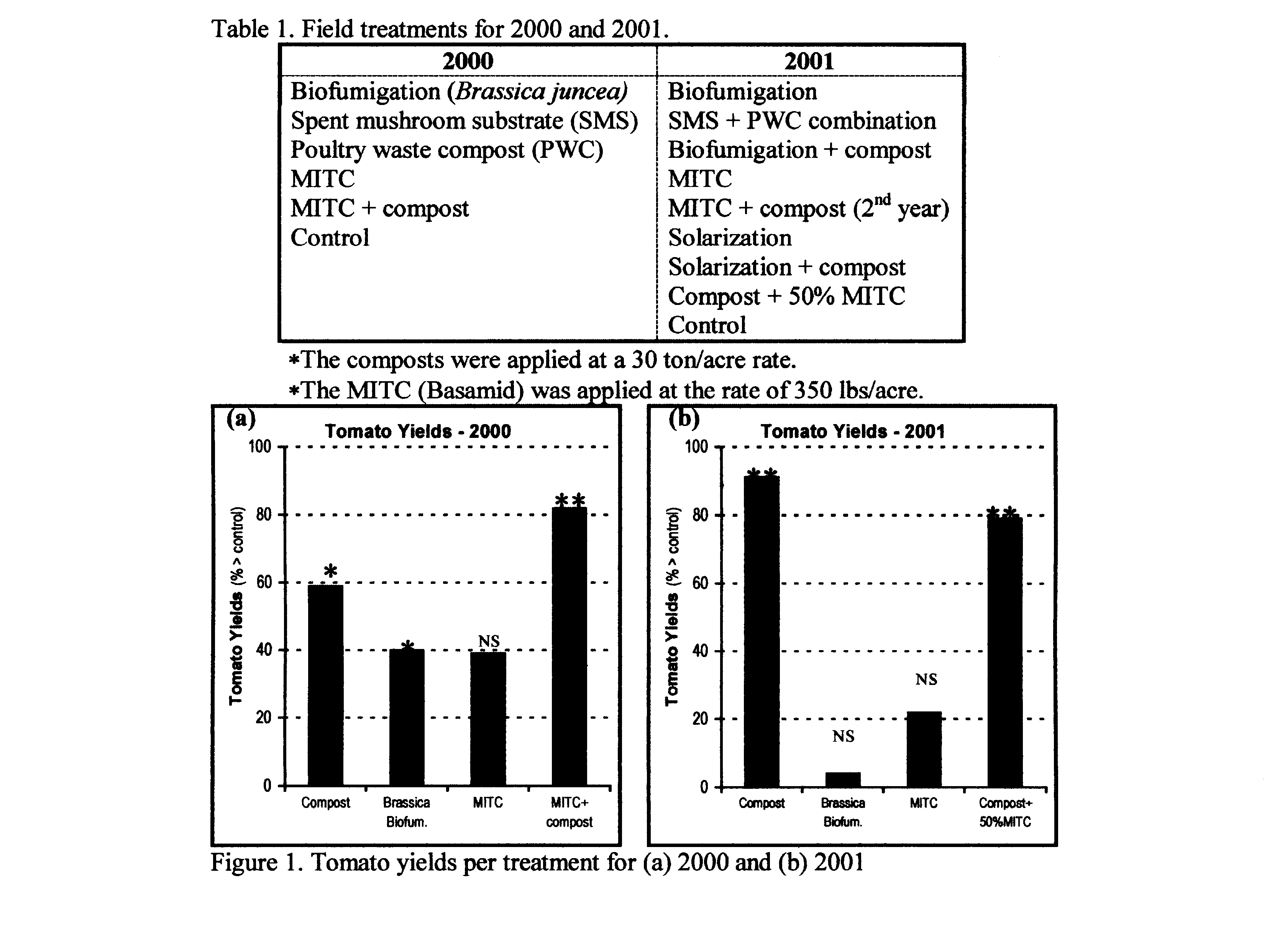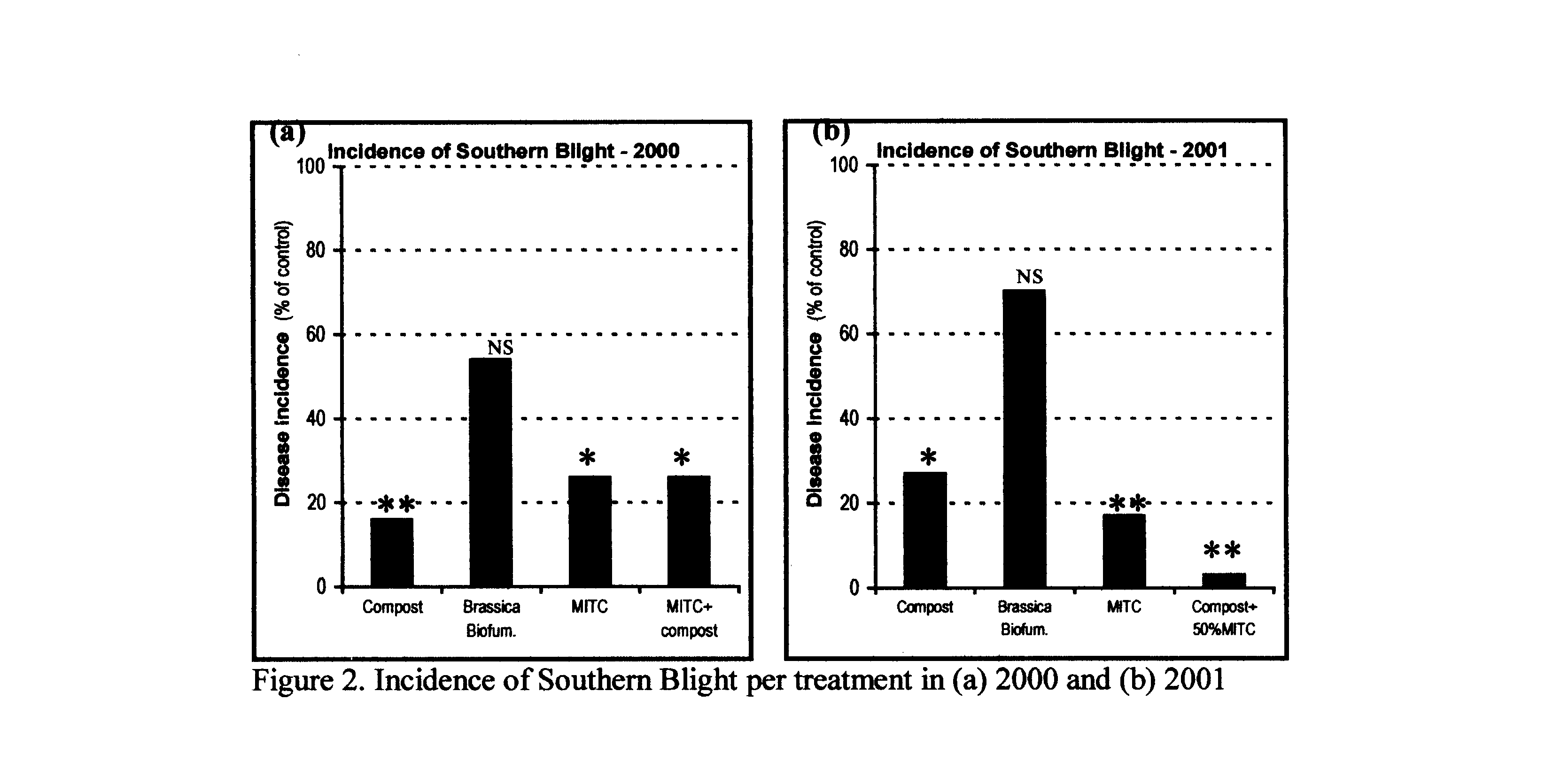Utilizing Integrated Pest Management to Control Southern Blight of Tomato, Knoxville Experiment Station, 2001.
Martin Lyons and Carl Sams
Interpretive Summary
Pre-plant soil treatments utilizing composted amendments, biofumigation, solarization, and low dosage dazomet (Basamid) produced higher yields and resulted in a lower incidence of the soilborne disease, southern blight, than did controls.
Introduction
The removal of methyl bromide from the marketplace will likely require growers to adopt an integrated approach to disease management. Our research project is examining the effectiveness of combining chemical and non-chemical methods to reduce the incidence of southern blight in plasticulture tomato production to economically manageable levels. Accumulating evidence suggests that composted soil amendments, solarization, and biofumigation with Brassica cover crops all have the potential to reduce phytopathogenic fungal propagule numbers to some degree. In fields extensively infested with S. rolfsii, the causal agent of southern blight, it is probable that elevated propagule numbers will need to be initially reduced via a chemical fumigant. We will be examining the ability of Methyl Isothiocyanates (MITC), such as the commercially available compounds dazomet and metam-sodium, to substitute for MeBr for this purpose. When disease is evident but soil tests reveal more moderate numbers of propagules present non-chemical means of suppression may prove to be sufficient for control to tolerable levels.
The utilization of composts will result in the re-establishment of a balanced soil microbial community that will be capable of providing extended and sustainable disease suppression. Our study focuses on enhancing the beneficial effects of composts via either combining them with other non-chemical treatments such as biofumigation and solarization or via a compost/MITC combination. In order for any of the tested treatment combinations to be adopted commercially the mode of action of disease suppression needs to be described and documented more extensively. That can be accomplished via a detailed exploration and description of the changes that occur in the soil microecology. This knowledge will permit meaningful testing and analysis of any potential soil treatment, thus, providing growers with a test that may be used to determine when a chemical or biological control is needed in an integrated production system.
Materials and Methods
Field studies: In 2000 a three-quarter acre research site was established at the Knoxville Agricultural Experiment Station. The 2000 and 2001 field treatments are displayed in Table 1. The rows were prepared using common methods for forming raised beds covered with blackplastic mulch. Yield data was collected throughout the season. An inspection of each plant for southern blight was also conducted. This data was also collated and compared to treatment type.
Results and Discussion
The first year of the field study demonstrated that tomato yields are greatly influenced by soil treatment type. The compost amended plots produced yields 59% higher than controls. MITC and biofumigation plots had 39 and 40% higher yields than controls. However, the combined MITC + compost plots produced the highest yields - 82% above control (Fig.1a). In 2001 the compost plots yielded 91% above controls and the "compost + 50% MITC" plots 79% higher (Fig.1b). In 2000 the incidence of southern blight was also lower in all treatment plots compared with control (Fig.2a). The most noteworthy result from 2001 was the low incidence of disease in the "compost + 50% MITC’ treatments - 5% of control (Fig.2b). These results, and similar ones from other researchers, suggest that the most effective treatments for prevention of tomato diseases and enhanced yields may be those that integrate two or more control mechanisms while also favoring the growth of beneficial soil organisms.
Table 1. Field treatments for 2000 and 2001.
|
2000 |
2001 |
|
Biofumigation (Brassica juncea) |
Biofumigation |
|
Spent mushroom substrate (SMS) |
SMS + PWC combination |
|
Poultry waste compost (PWC) |
Biofumigation + compost |
|
MITC |
MITC |
|
MITC + compost |
MITC + Compost (2nd year) |
|
Control |
Solarization |
|
Solarization + compost |
|
|
Compost + a50% MITC |
|
|
Control |
*
The composts were applied at a 30 ton/acre rate.*
The MITC (Basamid) was applied at the rate of 350 lbs/acre.
Figure 1. Tomato yields per treatment for (a) 2000 and (b) 2001

Fig 2.